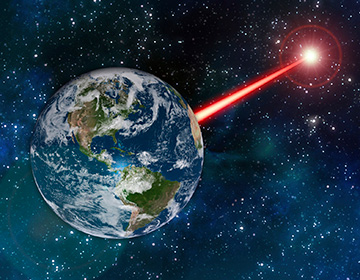
An MIT study proposes that laser technology on Earth could emit a beacon strong enough to attract attention from as far as 20,000 light-years away. [Image: MIT News]
Since the early 20th century, humans have been leaking their radio-frequency signals into the nearby universe. Extraterrestrial civilizations, if there are any, have yet to respond. But what would happen if Earth focused a powerful laser beam at one of the known extrasolar planets in our galactic neighborhood?
A pair of U.S. researchers has worked out the mathematics of this scenario and concluded that current or near-future laser technology could indeed produce a signal detectable up to 20,000 light-years away (Astrophys. J., doi:10.3847/1538-4357/aae380). Such a signal, of course, would need to be bright enough to stand out from the sun's glare from the point of view of distant extraterrestrial civilizations. But that feat, the researchers say, might be accomplished with cutting-edge high-power lasers and the next generation of large ground-based telescopes.
Calculating extraterrestrial laser signaling
James R. Clark, a graduate student at the Massachusetts Institute of Technology (MIT), USA, began the calculations as a project for a class taught by Kerri Cahoy, associate professor of aeronautics and astronautics at MIT. For examples of potential homes for extraterrestrial civilizations, the pair considered two recently discovered systems with planetary bodies in the so-called habitable zone (that is, at the right distance from the host star for liquid water to exist on the planet’s surface). In 2016, such a planet was found around Proxima Centauri, the nearest star to our sun, and last year, three of the seven confirmed planets around a more distant star, Trappist-1, were located in that just-right region. Since both stars are considerably cooler and dimmer than our sun, their planets' orbital radii are roughly 3 to 5 percent of Earth's.
Clark and Cahoy studied many factors involved in extraterrestrial laser signaling. One is the “detectable zone width”—the size of a beam that would stand out from both background noise and the central star of a planetary system. That dimension of a useful beam depends not just on the signal-to-noise ratio at the center of the beam, but also the Rayleigh length—the distance that a beam travels before its cross-sectional area doubles—and a threshold power that is 10 times the typical fluctuations in the star's light output.
For potential transmitters, the MIT pair considered various types of high-power lasers. The candidates they studied included the Airborne Laser, a megawatt-class near-infrared laser developed by the U.S. military for ballistic missile defense; a hypothetical megawatt-class laser operating at 785 nm for pickup by silicon-based detectors; and a phased-array architecture that could emit 1011 W, as proposed by one of the scientists working on Breakthrough Starshot.
Completing the handshake
The researchers found that an earthbound laser–telescope pair could generate effective isotropic radiated power comparable to that of the sun, but the tradeoff would be a narrow beam that had to be timed precisely to “hit” an exoplanet in its orbit. The right combination of parameters—laser power, telescope aperture—could be tweaked to get a reasonably sized beam, at least for Proxima Centauri. The team also considered what kind of beam nearby extraterrestrials, if they exist, would have to aim at Earth to complete the “handshake.”
In the end, according to Clark and Cahoy, the probability of signaling other worlds boils down to logistics and human will. Since more and more astronomers are surveying exoplanet systems in the infrared, the MIT researchers urge them to search through the survey results for anomalous emission lines that might be coming from an alien “porch light.”
